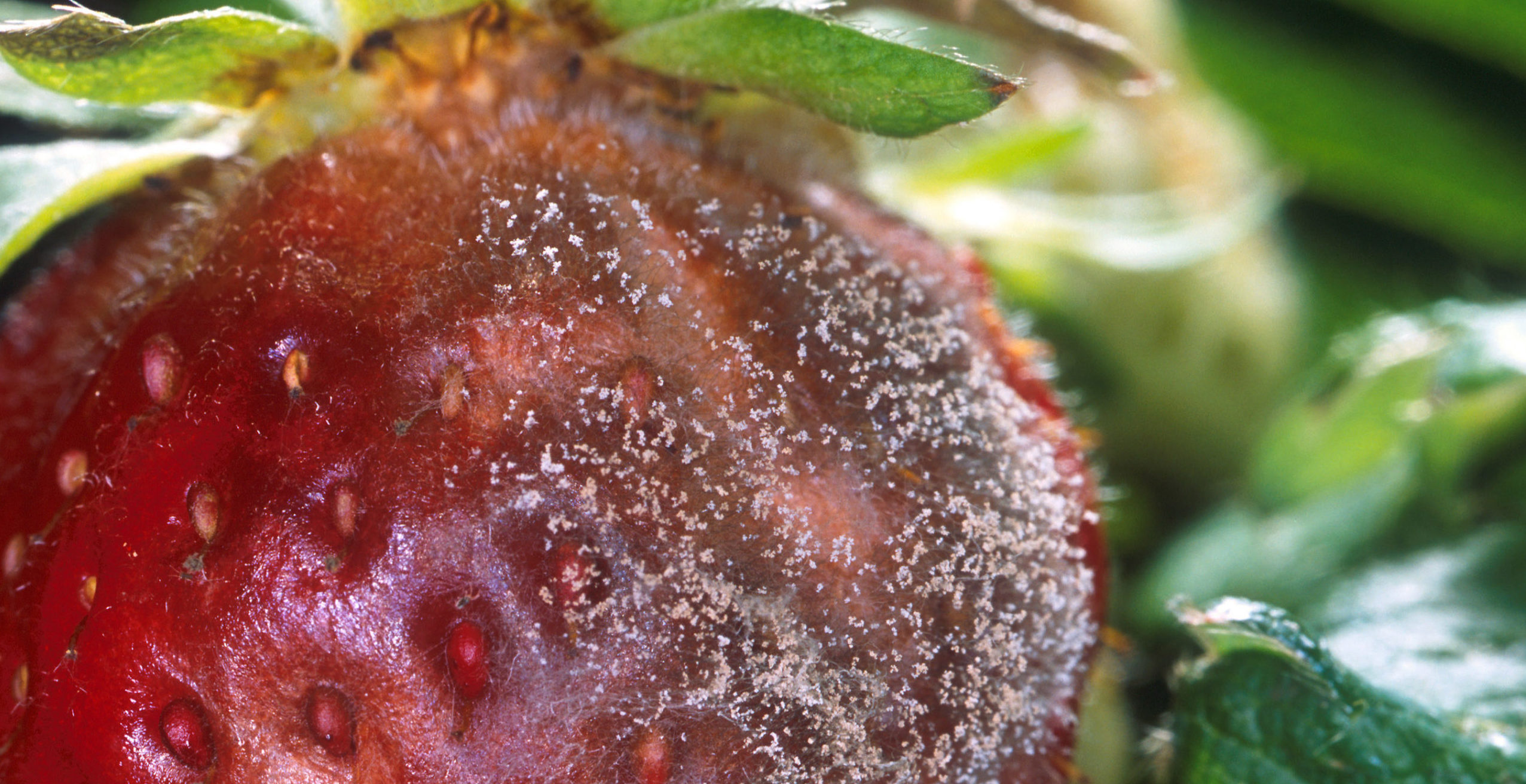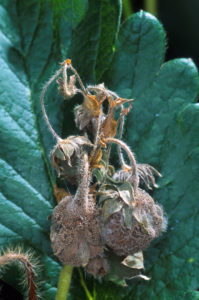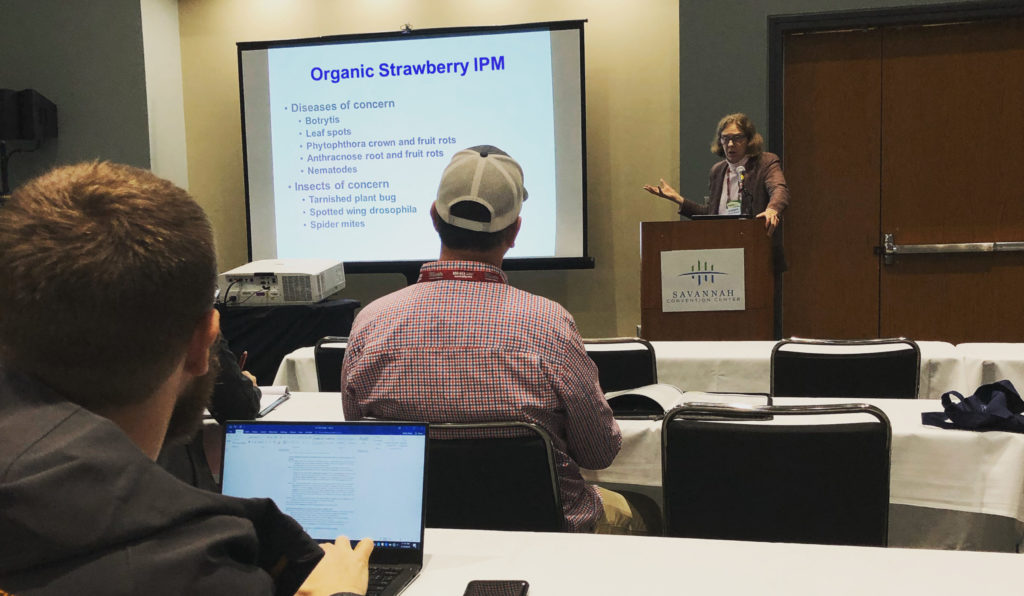
May 28, 2020
Southeast’s organic berry growers deal with diseases
Healthy plants in pleasant plantings are the best way to deal with the challenges of berry growing in the Southeastern United States.
University of Georgia Associate Professor and Extension Plant Pathologist Elizabeth L. Little spoke in February at the Southeast Regional Fruit and Vegetable Conference on organic disease management in small fruit.
“When it comes to disease, it’s all about prevention,” she said.
The Southeast’s humidity and warm weather make for an environment of high disease pressure. Little said that in this environment many organic-approved fungicides have a low efficacy. Nevertheless, many Georgia growers do still grow organic berries for farm markets and even commercial sales, she said.
Strawberries are often grown on a small scale, and the plants are often treated as an annual, while some organic blueberries are grown at a larger scale for the wholesale market. Commercially growing blackberries is difficult because of cane infections and pest pressure (especially spotted wing drosophila).
In general, it’s important to battle for berries by giving the plants the best possible conditions for their biology, she said. Plant health, sanitation and genetic resistance are the basis of organic disease management.
Strawberries
“Actually, strawberries go pretty well here in southern Georgia,” Little said.
Disease challenges to strawberries include botrytis, leaf spots, phytophthora crown, anthracnose, fruit rots and nematodes.
“Root knot nematode is a major constraint to organic production in the Southeast,” she said. “They will build up, if you don’t pay attention.”

While nematodes should be monitored, fungal diseases will sometimes crop up following a rain event. Berries and plants with diseases like botrytis must be immediately removed from the area – not just thrown out of the row, Little said.
Keeping the soils strong and clean is important. She recommends diverse crop rotation, building soils and mulching. Sun hemp can be used as a summer cover crop for strawberries, she said (it’s problematic with blueberries because of the required soil acidity). Sodded row covers can be established with fescue or various types of millet. Soils should be improved prior to planting – it’s not necessary to add compost every single year, but strawberries do enjoy strong soil.
Commercial growers in the Southeast typically grow strawberries as an annual, buying transplants in October to produce a spring crop and then pulling them out of the field, Little said. Getting clean, high-quality transplants is vital. Mulching can be done with organic materials, but most growers use black fabric, which lasts longer than plastic and unlike plastic can be left in place.
In Little’s view, the aggressive growth of strawberries risks disease.
“You don’t want to push the plants in organic so they’re big and the berries are big and juicy and huge – a lot of nitrogen and so forth,” she said. “You want to do conservative fertilization.
“There’s a tendency with strawberries to want to get those huge roots and those big bushy plants, and you’re going to get more disease. And it’s true with all of these crops. You want to be an organics conservative, especially with the nitrogen, but all the nutrients.”
Blueberries

Selecting the right kind of site is essential for organic blueberry production, Little said. The ground should be acidic, with a pH of 4 or 5, and be well-drained and fertile. Growers should look out for perennial grasses such as Bermuda.
She recommends growers avoid replanting in old blueberry sites – if they must, they should plant a cover crop for 1-2 years. Selecting high-quality plants is important, she said, and native-derived rabbiteye blueberries seem to grow the best.
Regular mulching with pine bark helps with disease management, she said.
Poor site selection can lead to a host of disease problems: Water-logged soils will lead to root rot. Plant stress from site problems can make them susceptible to botrytis canker and dieback of the bush.
Little said that mummy berry is the blueberry growers’ major problem – fighting the disease is mostly about breaking the lifecycle of disease by pulling out the spore-producing “mummies” that sprout from infected, dropped berries.
“Prevention is all about getting rid of the mummies,” Little said. It’s a major problem for large growers. “I don’t see this in small, isolated plantings, but just be aware. Don’t let them build up.”
Blackberries
Growing organic blackberries has been a challenge for Georgia growers, Little said.
“I know they grow wild everywhere, why can’t we grow them? Well, these are way different than what grow wild. … They need TLC.”
There are a variety of problems with the brambles in addition to disease. Little said blackberries don’t like weed competition, and like their water only “when they want it.” On the pest side, blackberries suffer greatly from spotted wing drosophila, and generally speaking the bushes don’t seem to handle stress well.
“You can abuse a blueberry to some extent – and strawberries – but blackberries will die on you,” she said.
Cane blight is the main concern as far as disease goes, she said.
A stress disease, it usually causes current-year canes to die. To prevent the disease from spreading, old fruiting canes should be cut out and need to be taken of the field, burned or buried. Copper can be applied right after pruning to protect the fruiting cane, she added.
Rusts to the blackberry plant should be diagnosed by Extension, she said. Orange Rust is systemic and causes the whole plant to go downhill, however it looks similar to leaf and cane rust, which isn’t quite so serious.
“One you have to yank out the other plant, the other you don’t,” she said.
Above, Botrytis cinerea sporulation on a ripe strawberry. Photo: Scott Bauer/USDA






